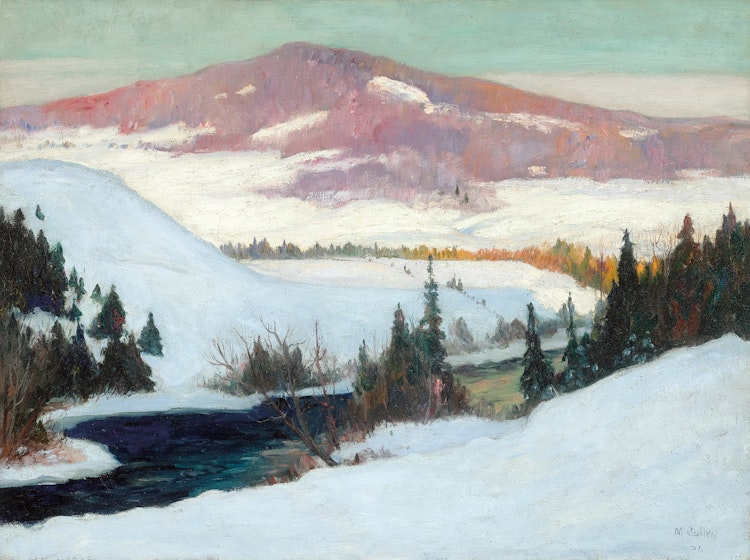Winter, Mont Tremblant by Maurice Galbraith Cullen

Maurice Cullen
Winter, Mont Tremblant
oil on canvas
signed lower right; Cullen inventory no. 1603
24 x 32 in ( 61 x 81.3 cm )
Auction Estimate: $40,000.00 - $60,000.00
Price Realized $36,000.00
Sale date: November 27th 2024
Private Collection, Toronto
A.K. Prakash, "Impressionism in Canada: A Journey of Rediscovery," Stuttgart, 2015, pages 302, 313
With fixed determination, Cullen sketched outdoors, often while standing in frigid temperatures on snowshoes. The painter would make and prepare his own small painting boards, on which he would sketch on-site. Cullen would then work them up to larger canvases in his studio during the summer months. Later, the same methodology would become the core practice of the artists of the Group of Seven. "Winter, Mont Tremblant" wonderfully exemplifies Cullen’s mastery at capturing the subtle play of sunlight on snow. The Laurentian mountain rises grandly in the distance, deftly rendered in shifting, warm hues. Prakash observed, “He excelled in crisp winter landscapes in the radiant northern light... He was determined to record the texture and varied colours of his country in impasto layers of paint - and no other Impressionist artist did it better.”
Share this item with your friends
Maurice Galbraith Cullen
(1866 - 1934) RCA
Maurice Cullen was born in St. John's Newfoundland, 1866. His family moved to Montreal in 1870. He studied sculpture at Monument National under Philippe Hebert. He assisted Hébert in the making of the Apostle figures for the facade of St. James Cathedral. The legacy left to him after the death of his mother in 1887 enabled him to travel to Paris and study sculpture at the Ecole des Beaux-Arts. He was tremendously impressed by the work of Claude Monet and other Impressionists which swayed him to become a painter. He studied painting under Eli Delauney in 1889 at the Beaux-Arts and in 1892 left the school to paint landscapes at Moret, Every, and Le Pouldu. In 1894 five of his paintings were shown at the Salon. On a trip to Brittany he met the Norwegian painter Fritz Thaulow, they had much in common. Thaulow may have influenced him in choosing winter landscapes.
In 1895 he was elected Associate of the Societe nationale des Beaux-Arts, France. That same year he returned to Montreal where he opened a studio, making sketching trips along the St. Lawrence near Quebec City and Beaupre. By 1897 he was exhibited with the Royal Canadian Academy and participated in Spring Exhibitions of the Art Association of Montreal. At the time there was very little interest in Canadian snow scenes. In 1900 Cullen held an exhibition of his French and Canadian paintings at the Fraser Institute but sold none of these works. They offered little competition for the Dutch 19th Century paintings which were then in vogue. His lack of success left him undeterred however, and he continued sketching in Montreal and Levis. His night scenes of shops with their glowing windows reflecting light in the snowy streets, were breaking new ground by their “ordinary everyday subjects” as was noted by Dr. Hubbard in his book.
In 1907 Cullen was elected full member of the Royal Canadian Academy. He was a fine craftsman and was very careful with the media he used. He worked with thick surfaces throughout, or totally thin surfaces, and presently his canvases pose few problems for restorers. He seldom used more than eight colours in oil painting because he was wary of the manufactured colour blends. He made his own pastels from earths and other pigments which he then applied with a minimum of rubbing.
By the early teens he was exhibiting regularly with the Canadian Art Club in Toronto and in 1918 Cullen went to France as an official war artist with the rank of captain. One of his stepsons, Robert Pilot, became a distinguished painter and President if the Royal Canadian Academy. Cullen moved toward clearer atmospheres in his paintings and away from the soft and misty atmospheres of the French Impressionists. This development was perhaps epitomized in his canvas “Deep Pool”. He painted on the Island of Orleans with Horatio Walker, Edmond Dyonnet, and William Brymner and painted with F. S. Coburn whim he encouraged in winter landscapes, also James Wilson Morrice and others. He died at Chambly, Quebec, at the age of 68. A large retrospective exhibition of his works was held in 1956 at the National Gallery of Canada.
Source: "A Dictionary of Canadian Artists, Volume I: A-F", compiled by Colin S. MacDonald, Canadian Paperbacks Publishing Ltd, Ottawa, 1977

